Finite Element Analysis of the Breakdown Prediction for LDPE Stressed by Various Ramp Rates of DC Voltage Based on Molecular Displacement Model
Abstract
1. Introduction
2. Numerical Analysis and Governing Equations
2.1. Charge Transport Model
2.2. Molecular Displacement Model
2.3. Numerical Solving Procedure
3. Numerical Analysis Results
3.1. Charge Transport in Polymers
3.2. Current Density Calculation
3.2.1. Average Method
3.2.2. Energy Method
3.2.3. Comparison between Average Method and Energy Method
3.3. Breakdown Prediction with Molecular Displacement
4. Discussion
5. Conclusions
Author Contributions
Funding
Conflicts of Interest
References
- Ushakov, V.Y. Insulation of High-Voltage Equipment, 1st ed.; Springer: Berlin/Heidelberg, Germany, 2004; Volume 1, pp. 13–14. [Google Scholar]
- Cho, Y.S.; Lee, H.K.; Shim, M.J.; Kim, S.W. Characteristics of polymer insulator materials: Voltage-lifetime characteristics of DGEBA/MDA/SN system. Mater. Chem. Phys. 2000, 66, 70–76. [Google Scholar] [CrossRef]
- Hanley, T.L.; Burford, R.P.; Fleming, R.J.; Barber, K.W. A general review of polymeric insulation for use in HVDC cables. IEEE Electr. Insul. Mag. 2003, 19, 13–24. [Google Scholar] [CrossRef]
- Grzybowski, S.; McMellon, R.L. Electrical breakdown strength of XLPE cables under combined AC-DC voltage. In Proceedings of the IEEE Southeastcon’95, Raleigh, NC, USA, 26–29 March 1995; pp. 63–66. [Google Scholar]
- Okashita, M.; Ymaguchi, M.; Fujita, M.; Shintate, H.; Wang, S.; Shiono, T. Relationship between impulse breakdown and morphology of polyethylene. In Proceedings of the International Symposium on Electrical Insulating Materials, Toyohashi, Japan, 30 September 1998; pp. 549–552. [Google Scholar]
- Hoang, A.T.; Serdyuk, Y.V.; Gubanski, S.M. Charge transport in LDPE nanocomposites part II-computational approach. Polymers 2016, 8, 103. [Google Scholar] [CrossRef] [PubMed]
- Raju, G.; Katebian, A.; Jafri, S.Z. Breakdown voltages of polymers in the temperature range 23°–250 °C. IEEE Trans. Dielectr. Electr. Insul. 2003, 10, 117–127. [Google Scholar] [CrossRef]
- Diaham, S.; Zelmat, S.; Locatelli, M.L.; Dinculescu, S.; Decup, M.; Lebey, T. Dielectric breakdown of polyimide films: Area, thickness and temperature dependence. IEEE Trans. Dielectr. Electr. Insul. 2010, 17, 18–27. [Google Scholar] [CrossRef]
- Min, D.; Li, Y.; Yan, C.; Xie, D.; Li, S.; Wu, Q.; Xing, Z. Thickness-Dependent DC Electrical Breakdown of Polyimide Modulated by Charge Transport and Molecular Displacement. Polymers 2018, 10, 1012. [Google Scholar] [CrossRef] [PubMed]
- Zhao, L.; Liu, G.Z.; Su, J.C.; Pan, Y.F.; Zhang, X.B. Investigation of thickness effect on electric breakdown strength of polymers under nanosecond pulses. IEEE Trans. Plasma Sci. 2011, 39, 1613–1618. [Google Scholar] [CrossRef]
- Chen, G.; Zhao, J.; Li, S.; Zhong, L. Origin of thickness dependent dc electrical breakdown in dielectrics. Appl. Phys. Lett. 2012, 100, 222904. [Google Scholar] [CrossRef]
- Yin, W.; Schweickart, D. Dielectric breakdown of polymeric insulation films under AC, DC and pulsed voltages. In Proceedings of the 2009 IEEE Electrical Insulation Conference, Montreal, QC, Canada, 31 May–3 June 2009; pp. 292–296. [Google Scholar]
- Alison, J.M.; Hill, R.M. A model for bipolar charge transport, trapping and recombination in degassed crosslinked polyethene. J. Phys. D Appl. Phys. 1994, 27, 1291–1299. [Google Scholar] [CrossRef]
- Zhao, J.; Xu, Z.; Chen, G.; Lewin, P. Numerical modeling of space charge in polyethylene under AC fields. In Proceedings of the 2010 10th IEEE International Conference on Solid Dielectrics, Potsdam, Germany, 4–9 July 2010. [Google Scholar]
- Lewis, T.J. Charge transport, charge injection and breakdown in polymeric insulators. J. Phys. D Appl. Phys. 1990, 23, 1469–1478. [Google Scholar] [CrossRef]
- Kaneko, K.; Mizutani, T.; Suzuoki, Y. Computer simulation on formation of space charge packets in XLPE films. IEEE Trans. Dielectr. Electr. Insul. 1999, 6, 152–158. [Google Scholar] [CrossRef]
- Min, D.; Yan, C.; Mi, R.; Ma, C.; Huang, Y.; Li, S.; Wu, Q.; Xing, Z. Carrier Transport and Molecular Displacement Modulated dc Electrical Breakdown of Polypropylene Nanocomposites. Polymers 2018, 10, 1207. [Google Scholar] [CrossRef] [PubMed]
- Andersen, A.; Moser, K.; Dennison, J. Dependence of Electrostatic Field Strength on Voltage Ramp Rate for Spacecraft Materials. IEEE Trans. Plasma Sci. 2017, 45, 2036–2039. [Google Scholar]
- Thomas, A. The Effect of Voltage Ramp Rate on Dielectric Breakdown of Thin Film Polymers; Senior Theses and Projects, Utah State University Utah State University: Logan, UT, USA, 2007. [Google Scholar]
- Li, S.; Min, D.; Wang, W.; Chen, G. Modelling of dielectric breakdown through charge dynamics for polymer nanocomposites. IEEE Trans. Dielectr. Electr. Insul. 2016, 23, 3476–3485. [Google Scholar] [CrossRef]
- Min, D.; Wang, W.; Li, S. Numerical analysis of space charge accumulation and conduction properties in LDPE nanodielectrics. IEEE Trans. Dielectr. Electr. Insul. 2015, 22, 1483–1491. [Google Scholar] [CrossRef]
- Min, D.; Li, S. Simulation on the influence of bipolar charge injection and trapping on surface potential decay of polyethylene. IEEE Trans. Dielectr. Electr. Insul. 2014, 21, 1627–1636. [Google Scholar] [CrossRef]
- Dissado, L.A.; Fothergill, J.C. Electrical Degradation and Breakdown in Polymers; The Institution of Engineering and Technology: Stevenage, UK, 1992; Volume 1, pp. 223–224. [Google Scholar]
- Chandra Kusumasembada, A.; Teyssedre, G.; Le Roy, S.; Boudou, L.; Sinisuka, N.I. Assessment of a Charge Transport Model for LDPE through Conduction Current Measurement. Adv. Technol. Innov. 2017, 2. [Google Scholar]
- Le Roy, S.; Teyssèdre, G.; Laurent, C. Modelling space charge in a cable geometry. IEEE Trans. Dielectr. Electr. Insul. 2016, 23, 2361–2367. [Google Scholar] [CrossRef]
- Toomer, R.; Lewis, T.J. Charge trapping in corona-charge polyethylene films. J. Phys. D Appl. Phys. 1980, 13, 1343–1356. [Google Scholar] [CrossRef]
- Min, D.; Li, S.; Ohki, Y. Numerical simulation on molecular displacement and DC breakdown of LDPE. IEEE Trans. Dielectr. Electr. Insul. 2016, 23, 507–516. [Google Scholar] [CrossRef]
- Li, G.; Li, S.; Min, D.; Zhao, N.; Zhu, Y. Influence of trap depths on space charge formation and accumulation characteristics in low density polyethylene. In Proceedings of the IEEE International Conference on Solid Dielectrics (ICSD), Bologna, Italy, 30 June–4 July 2013; pp. 698–701. [Google Scholar]
- Li, Y.; Yan, C.; Min, D.; Li, S.; Xing, Z.; Zhang, L.; Zhang, C. Numerical Simulation on DC Breakdown of Polyimide Based on Charge Transport and Molecular Chain Displacement. In Proceedings of the 21st International Symposium on High Voltage Engineering; Springer: Berlin/Heidelberg, Germany, 2020; Volume 598, pp. 108–117. [Google Scholar]
- Le Roy, S.; Segur, P.; Teyssedre, G.; Laurent, C. Description of bipolar charge transport in polyethylene using a fluid model with a constant mobility: Model prediction. J. Phys. D Appl. Phys. 2004, 37, 298–305. [Google Scholar] [CrossRef]
- Hamed, B.; Fatiha, R. Numerical modeling of charge transport in polymer materials under DC continuous electrical stress. Trans. Electr. Electron. Mater. 2015, 16, 107–111. [Google Scholar] [CrossRef][Green Version]
- Boufayed, F.; Teyssèdre, G.; Laurent, C.; Le Roy, S.; Dissado, L.A.; Śgur, P.; Montanari, G.C. Models of bipolar charge transport in polyethylene. J. Appl. Phys. 2006, 100, 104105. [Google Scholar] [CrossRef]
- Lee, S.H.; Lee, S.Y.; Park, I.H. Finite element analysis of corona discharge onset in air with artificial diffusion scheme and under fowler-nordheim electron emission condition. In Proceedings of the 12th Biennial IEEE Conference on Electromagnetic Field Computation, Miami, Fl, USA, 30 April–3 May 2006; 2006; p. 283. [Google Scholar]
- Lee, H.Y.; Jung, J.S.; Kim, H.K.; Park, I.H.; Lee, S.H. Numerical and experimental validation of discharge current with generalized energy method and integral ohm’s law in transformer oil. IEEE Trans. Magn. 2014, 50, 257–260. [Google Scholar] [CrossRef]
- Hwang, J.-W.G. Elucidating the Mechanisms behind Pre-Breakdown Phenomena in Transformer Oil Systems. Ph.D. Thesis, Massachusetts Institute of Technology, Cambridge, MA, USA, 2010. [Google Scholar]
- Li, S.; Wang, W.; Yu, S.; Sun, H. Influence of hydrostatic pressure on dielectric properties of polyethylene/aluminum oxide nanocomposites. IEEE Trans. Dielectr. Electr. Insul. 2014, 21, 519–528. [Google Scholar] [CrossRef]

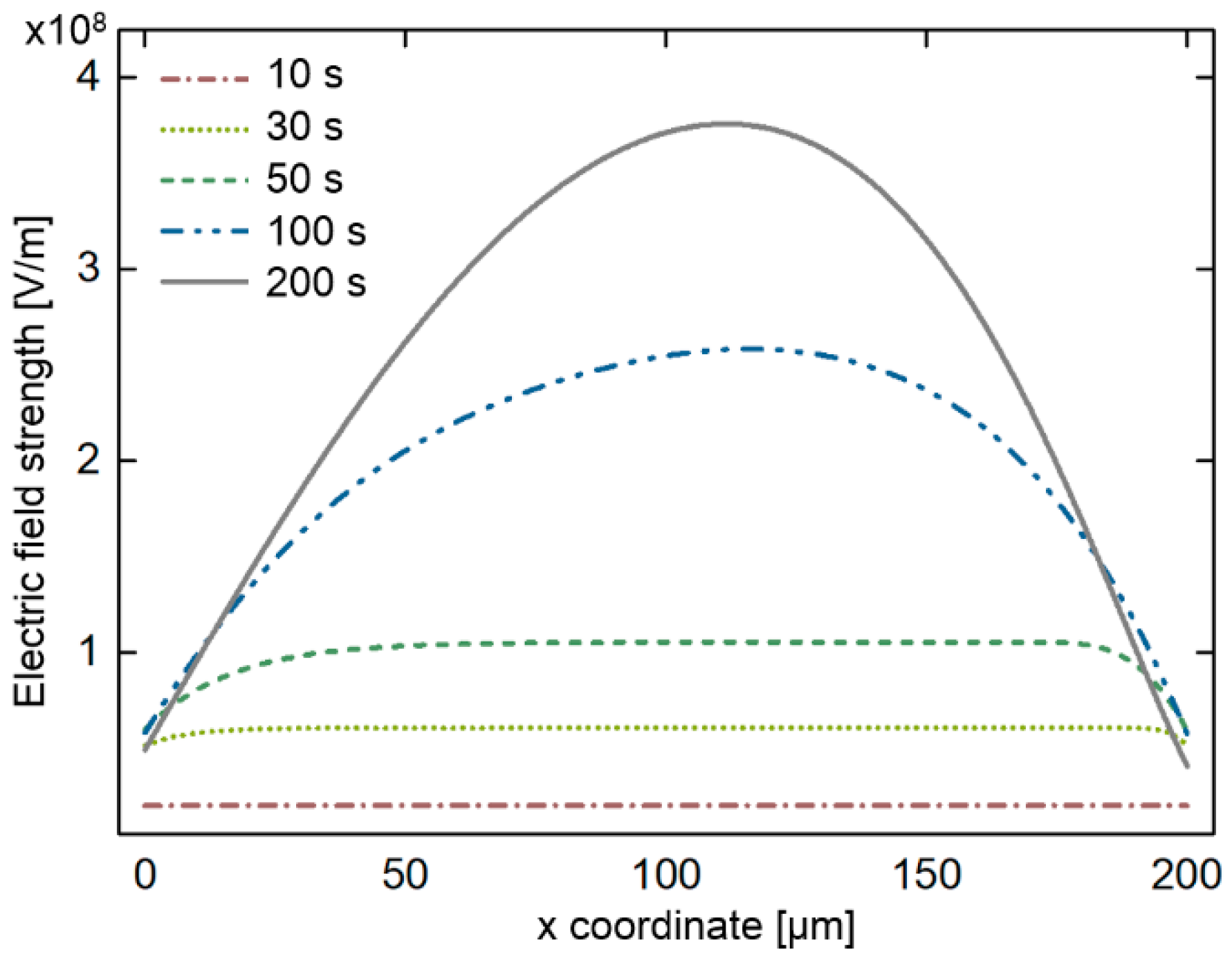
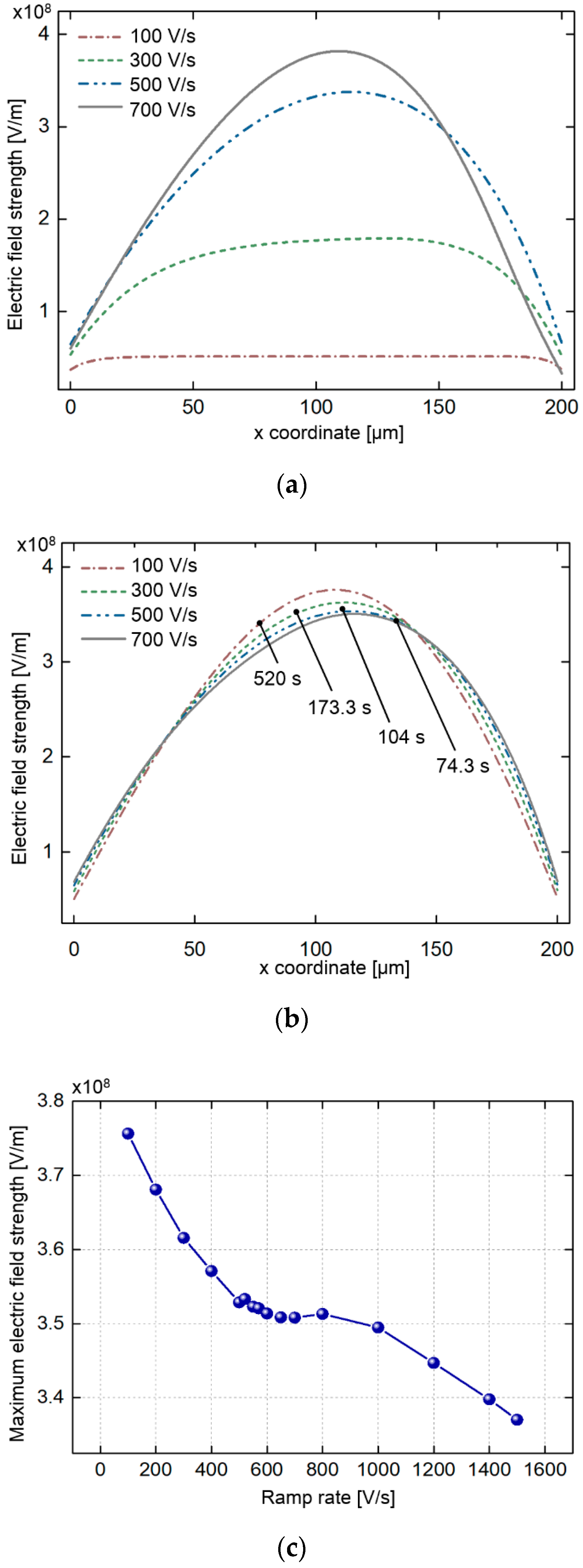
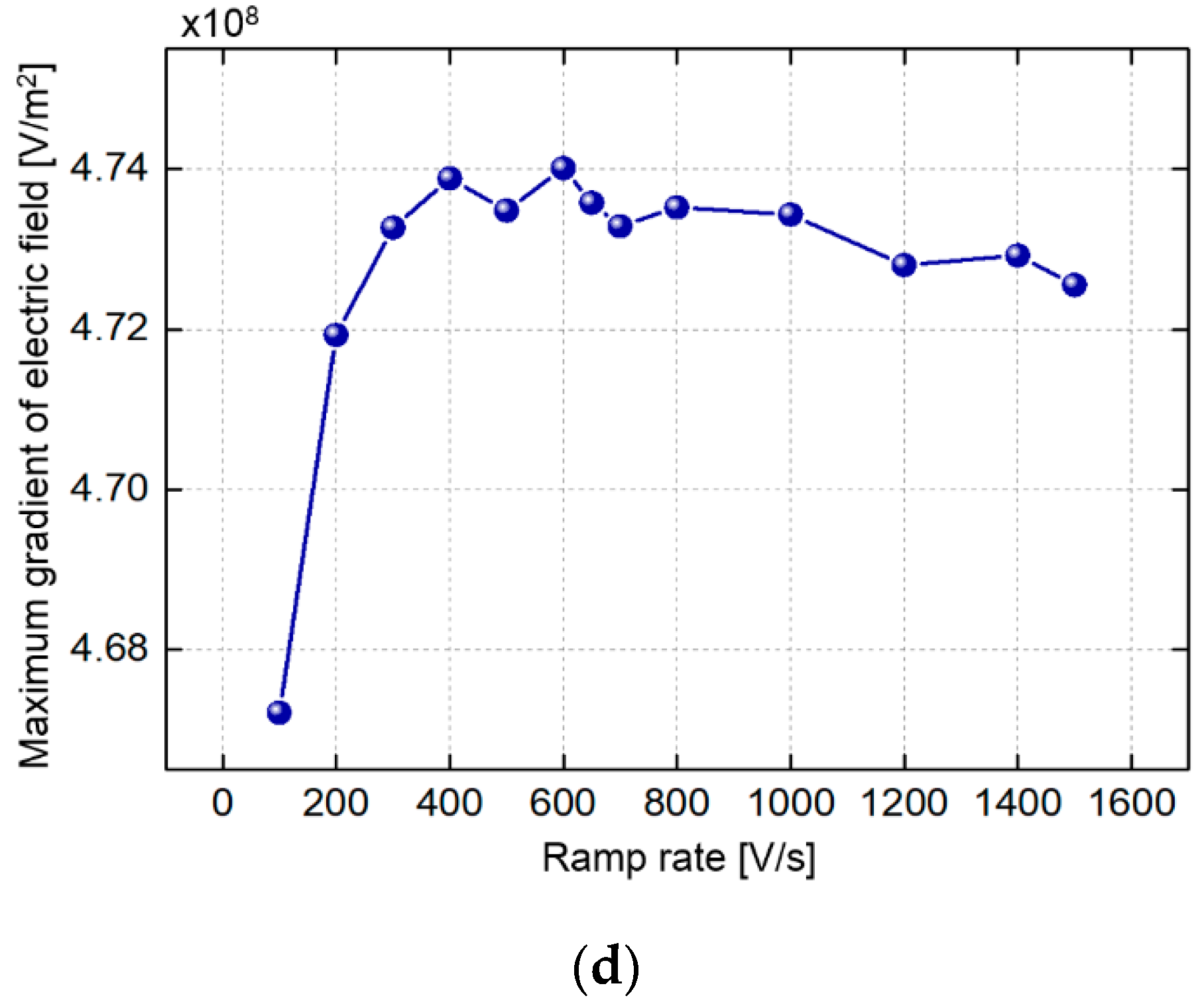



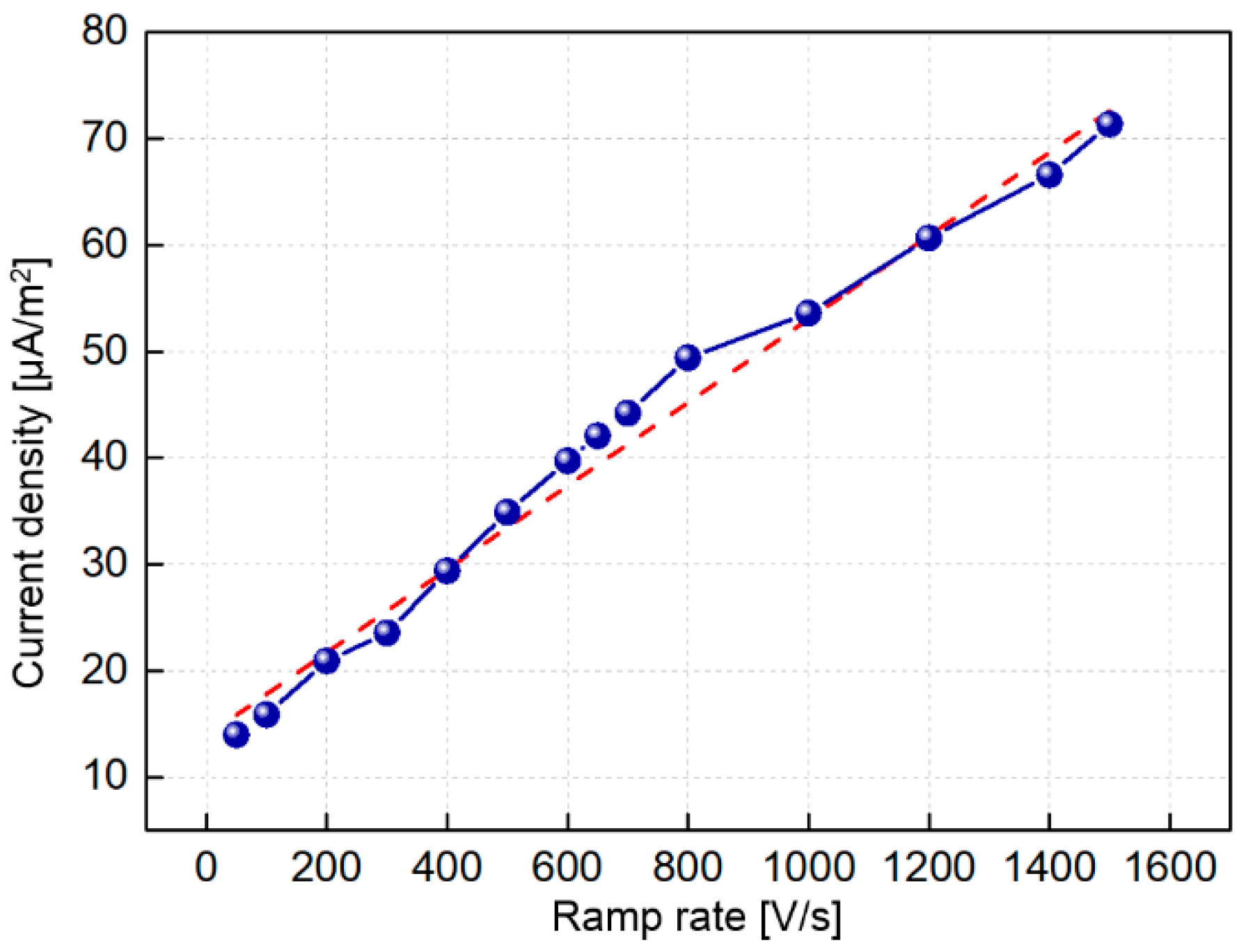
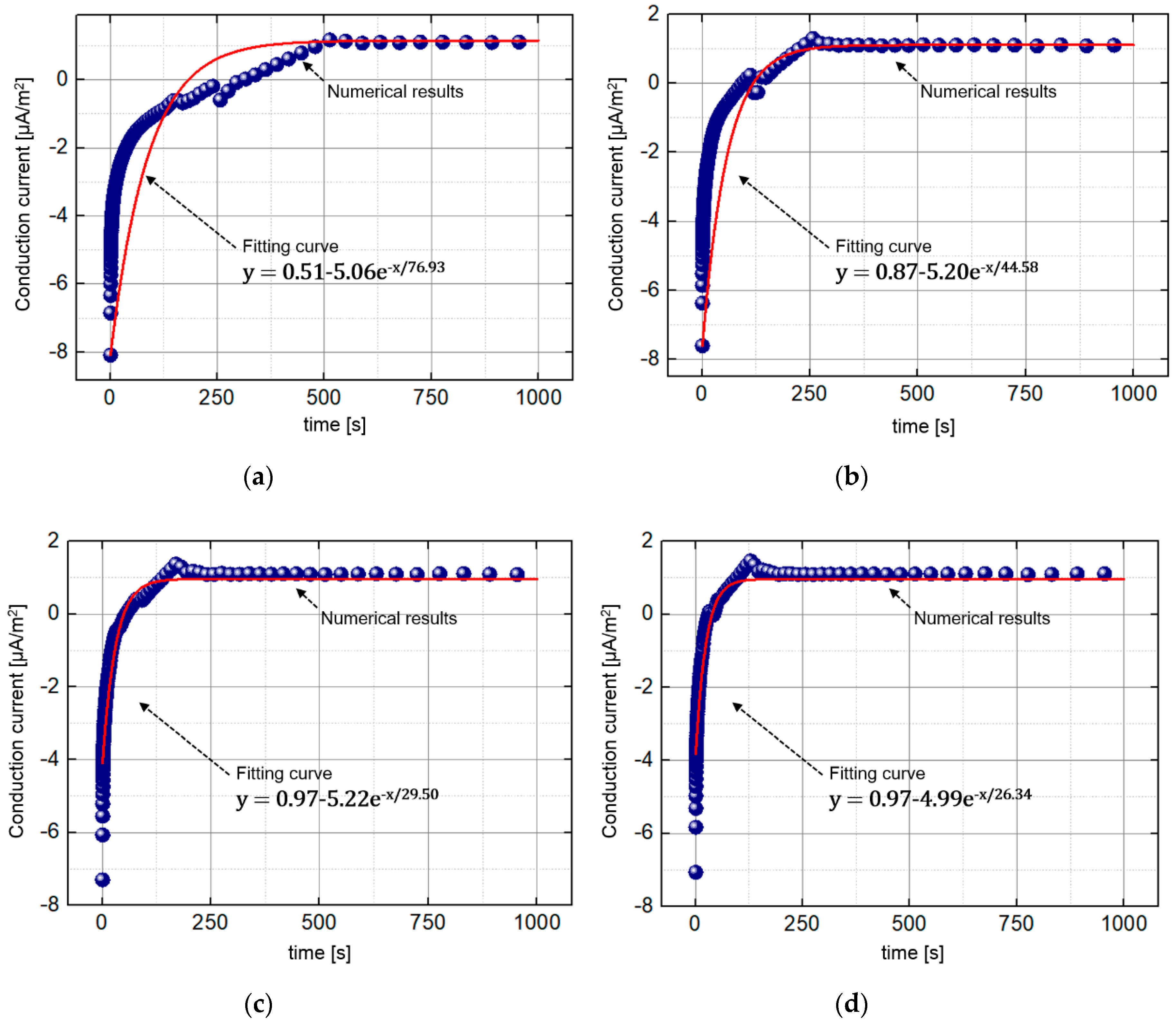
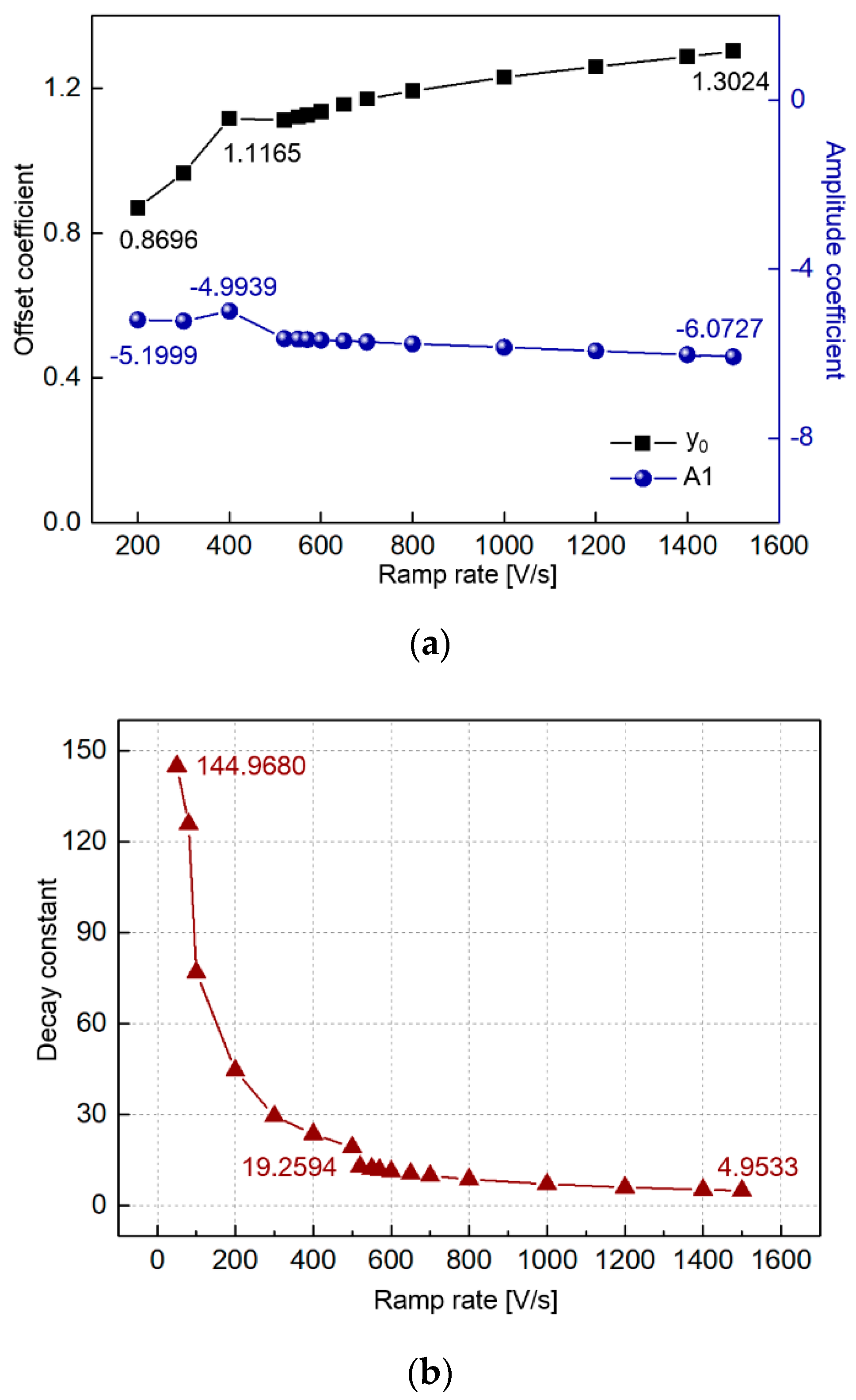
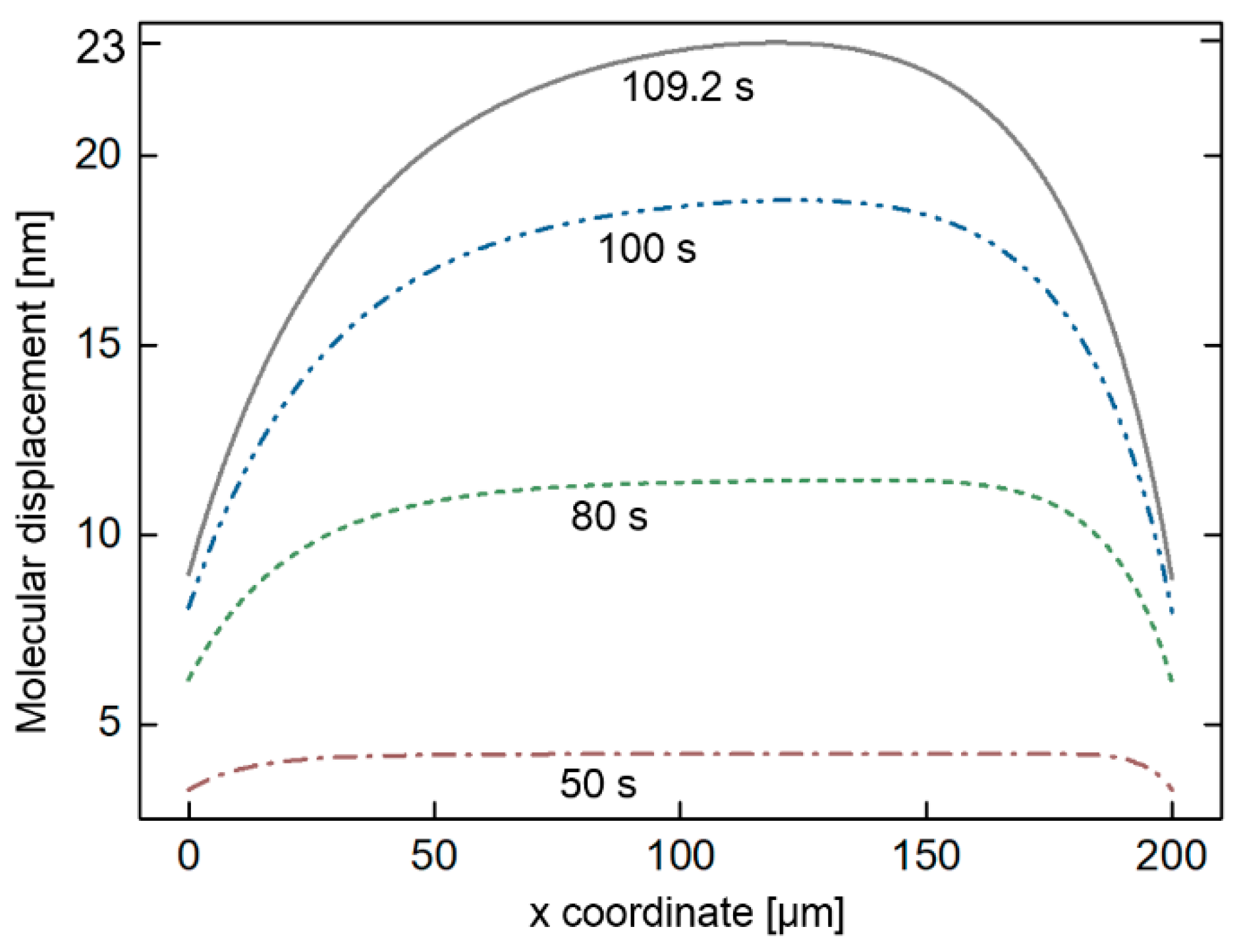


| Parameter | Value | |
|---|---|---|
| Injection barrier (eV) [14,26] | ||
| ΦB(e) | for electrons | 1.1 |
| ΦB(h) | for holes | 1.1 |
| Charge carrier mobilities (m2/V·s) [26] | ||
| μ0(e) | for electrons | 1.0 × 10−13 |
| μ0(h) | for holes | 1.0 × 10−14 |
| Deep trap energies (eV) [26,27] | ||
| ET(e) | for electrons | 0.93 |
| ET(h) | for holes | 0.93 |
| Deep trap densities (C/m3) [28] | ||
| eNT(e) | for electrons | 100 |
| eNT(h) | for holes | 100 |
| Ramp Rate (V/s) | Breakdown Strength (kV/mm) | Breakdown Voltage (kV) | Breakdown Time (s) |
|---|---|---|---|
| 10 | 38.75 | 7.39 | 738.81 |
| 50 | 90.66 | 16.29 | 325.76 |
| 100 | 133.11 | 22.74 | 227.42 |
| 200 | 196.85 | 31.60 | 157.99 |
| 400 | 288.78 | 43.70 | 109.25 |
| 800 | 365.77 | 52 | 76.15 |
| 1200 | 379.91 | 52 | 63.84 |
| 1500 | 388.53 | 52 | 58.66 |
© 2020 by the authors. Licensee MDPI, Basel, Switzerland. This article is an open access article distributed under the terms and conditions of the Creative Commons Attribution (CC BY) license (http://creativecommons.org/licenses/by/4.0/).
Share and Cite
Kim, M.; Kim, S.-H.; Lee, S.-H. Finite Element Analysis of the Breakdown Prediction for LDPE Stressed by Various Ramp Rates of DC Voltage Based on Molecular Displacement Model. Energies 2020, 13, 1320. https://doi.org/10.3390/en13061320
Kim M, Kim S-H, Lee S-H. Finite Element Analysis of the Breakdown Prediction for LDPE Stressed by Various Ramp Rates of DC Voltage Based on Molecular Displacement Model. Energies. 2020; 13(6):1320. https://doi.org/10.3390/en13061320
Chicago/Turabian StyleKim, Minhee, Su-Hun Kim, and Se-Hee Lee. 2020. "Finite Element Analysis of the Breakdown Prediction for LDPE Stressed by Various Ramp Rates of DC Voltage Based on Molecular Displacement Model" Energies 13, no. 6: 1320. https://doi.org/10.3390/en13061320
APA StyleKim, M., Kim, S.-H., & Lee, S.-H. (2020). Finite Element Analysis of the Breakdown Prediction for LDPE Stressed by Various Ramp Rates of DC Voltage Based on Molecular Displacement Model. Energies, 13(6), 1320. https://doi.org/10.3390/en13061320





